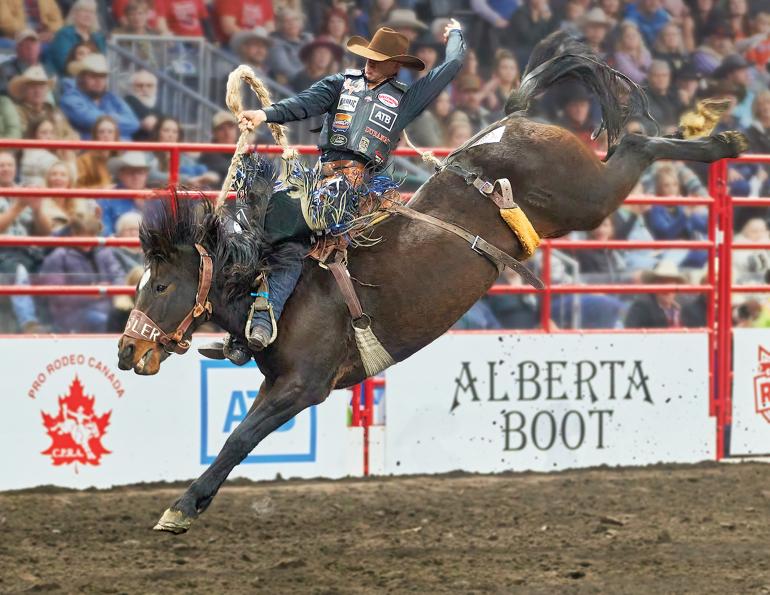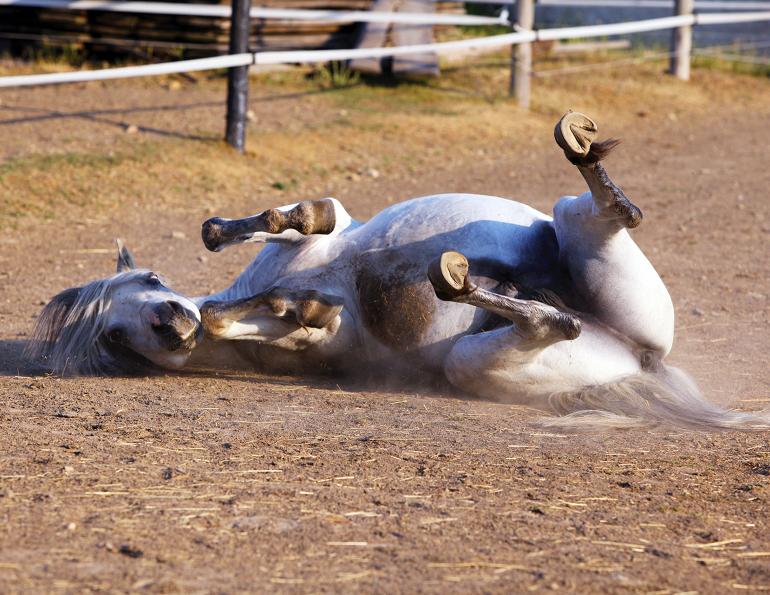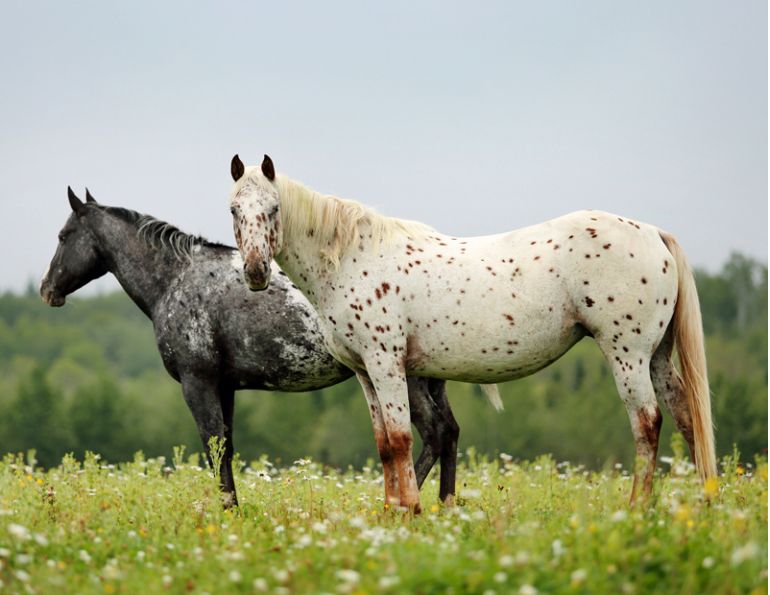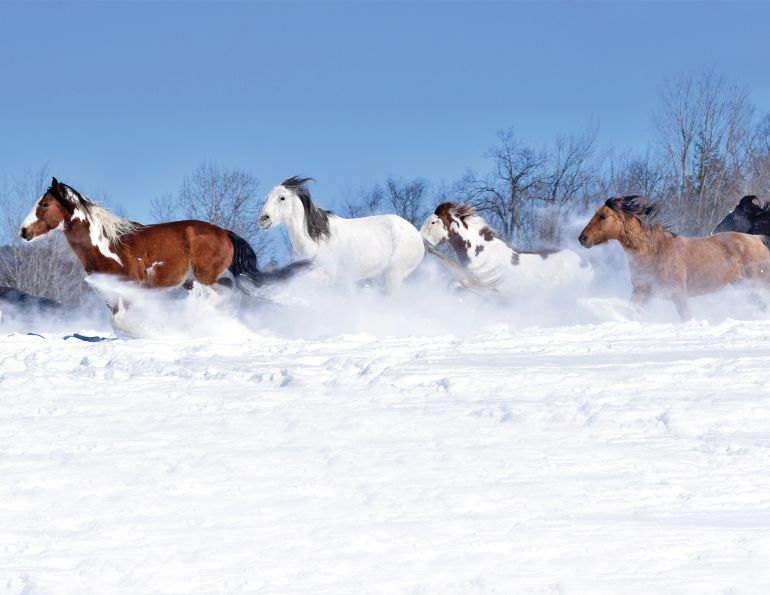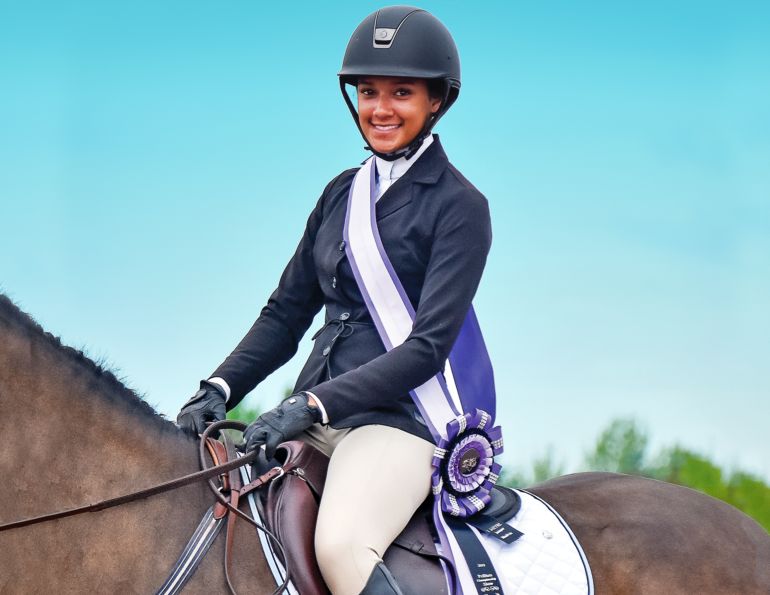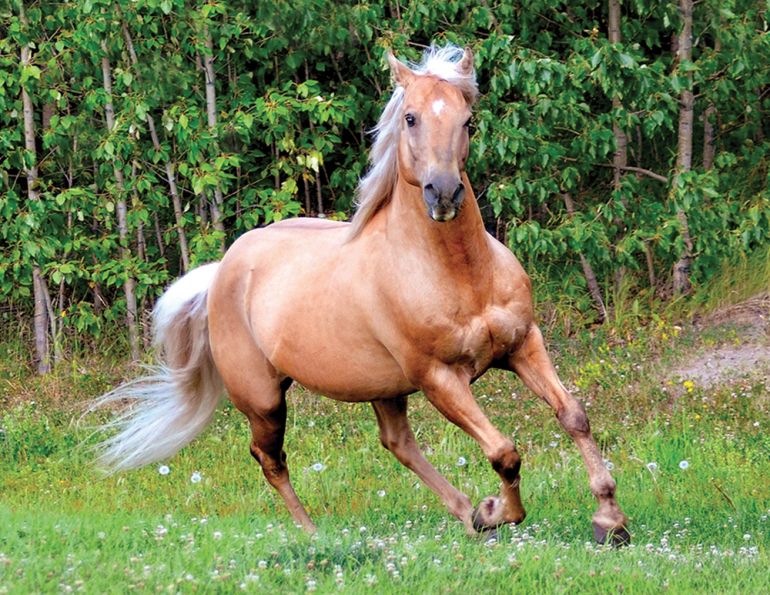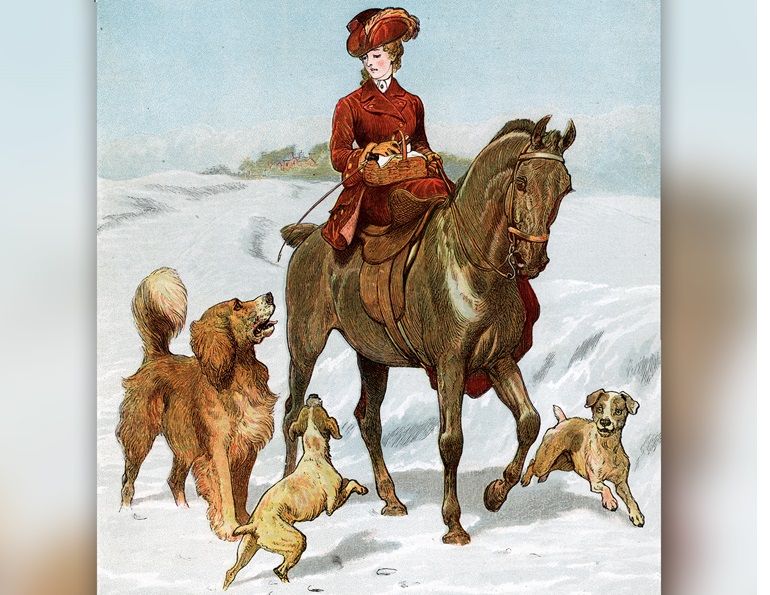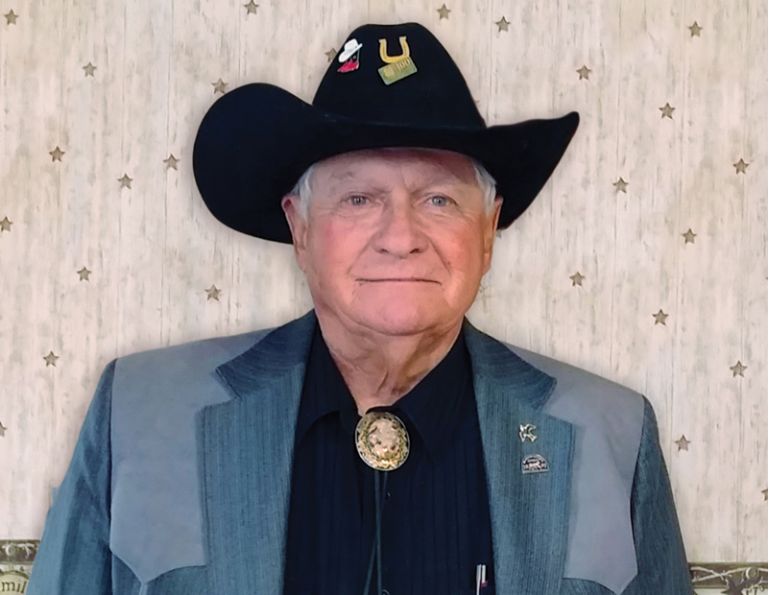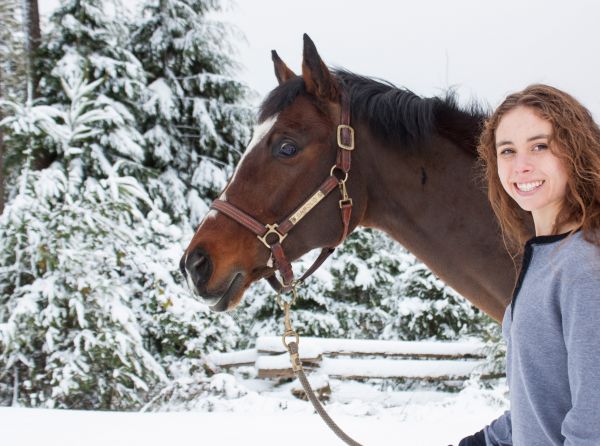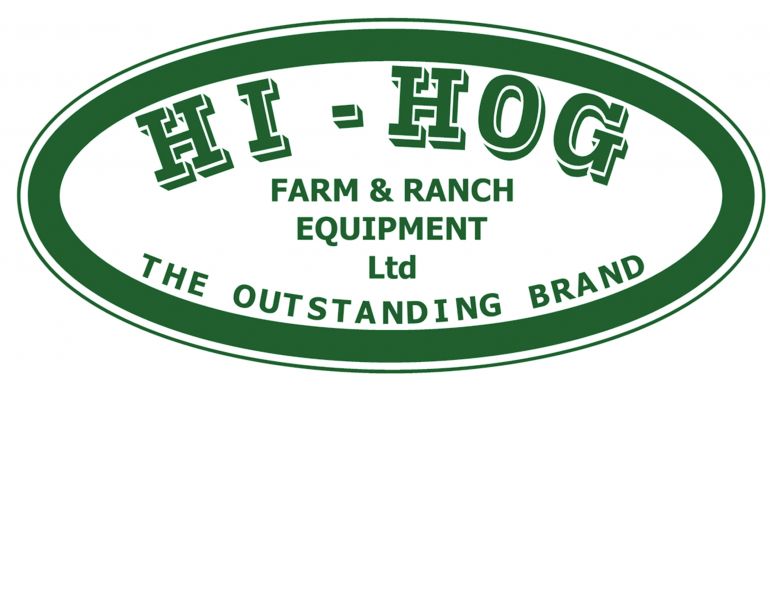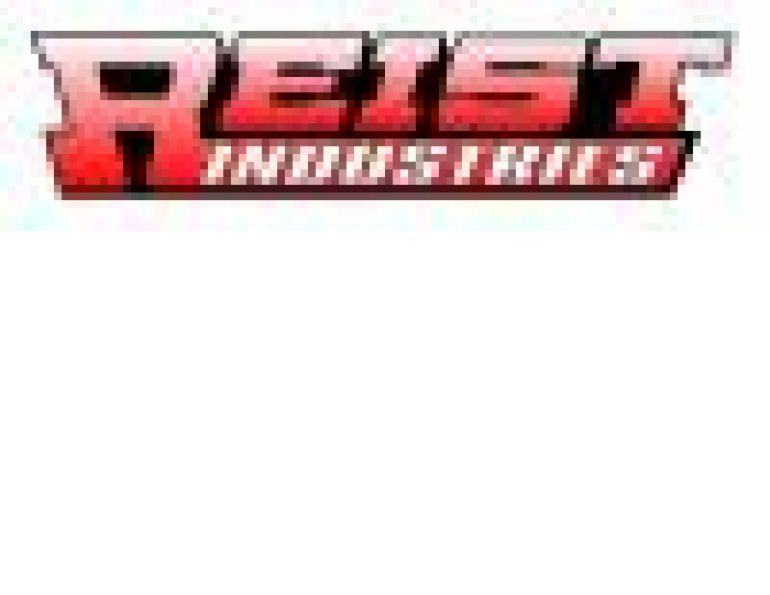By Tania Millen, BSc, MJ
Most riders don’t want a horse that bucks. But for bareback and saddle bronc riders competing at rodeos across North America, that’s exactly what they want — horses that buck and buck well for eight seconds.
Not every horse wants to buck or has the necessary athleticism to do it. Just as dressage movement, jumping skill, and cow sense have been selected by breeders, so has the innate ability and desire to buck. Bucking horses are purpose-bred, registered, and trained to do their job, just like other performance horses. Larger draft crosses are preferred because they have increased longevity, maintain their soundness, are stronger, and can handle the weight of cowboys on their back while maintaining their bucking style. They’re also bought and sold by breeders looking for new bloodlines and are transported to rodeos across North America where they make their living dumping riders and entertaining fans. And, just like other horse sports, bucking horses can make or break the careers of the bronc riders assigned to ride them.
Making Broncs
“I’m one of the smaller producers,” says Austin Siklenka, the 2023 Canadian Bucking Stock Contractor of the Year from Meadow Lake, Saskatchewan. He’s been breeding bucking horses for six years and has about 40 head of stock on his 1,600-acre operation. “We’re going for quality over quantity.”
As every horse breeder knows, developing horses with specific talents is a long game. Not every stallion and mare match-up will produce the expected talent, whether that’s a winning racehorse or a consistent bucking horse. Plus, it takes years to find out whether the match works.
Related: Falling Off a Horse: Dealing With An Unexpected Dismount
“The horses start at the bottom and work their way up,” says Siklenka. “We take the two- and three-year-olds, and strap on a surcingle that has a small box attached to it called a ‘dummy.’ The box has a remote connection to an electronic device so that after the horse leaves the chute and bucks a few times, the trainer can push a button to release the cinch and bucking strap, and the whole dummy contraption falls off. That way the horse learns to enter the chute, get fitted with a surcingle and bucking (flank) strap, then leave the chute and buck, all without a rider.
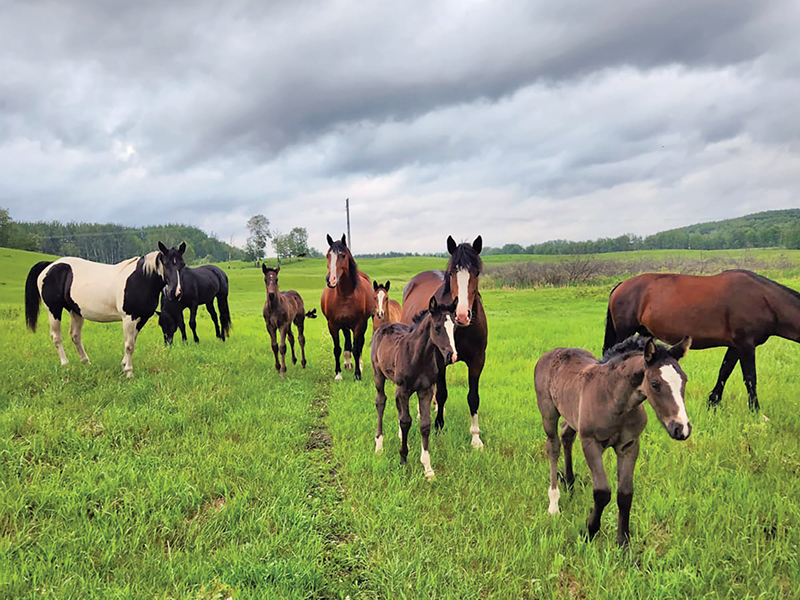
Mares and foals on Austin Siklenka’s farm in Meadow Lake, Saskatchewan. Photo: Austin Skilenka
“The horses are learning how to handle themselves,” says Siklenka. “They’re thinking and everything’s controlled. It’s like an athlete in training.
Related: Grated Coconut: Born to Buck
Related: Rhythm & Cadence for the Reining Horse
“A good bucker is consistent, user-friendly, gets high in the air, and kicks high over their head,” says Siklenka. Since professional riders are trying to make a living riding broncs, they don’t want horses that make quick changes of direction or funky dance moves. Just like other equestrians, bronc riders are looking for consistent horses that they can score well on.
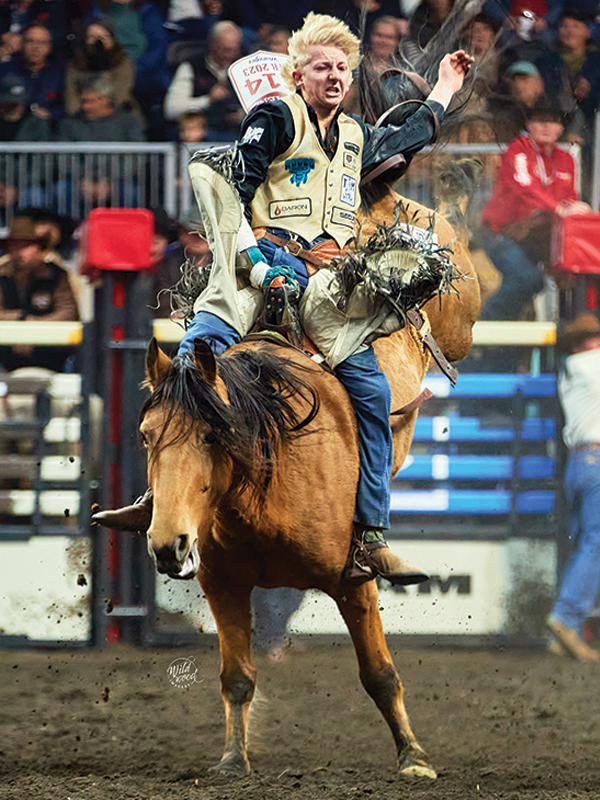
The horse and the contestant are each scored out of 50 points, for a total possible score of 100 points for a qualified ride. Very good scores are in the 80s; exceptional scores are in the 90s. Photo: Wildwood Imagery
As the two- and three-year-olds train and develop, they’re entered in futurity contests where they’re ridden by the “dummies” and judged for their skill. They aren’t ridden by humans until they’re at least age four.
“When the horses come up through the ranks with the dummy, we watch them and try to determine how good they’re going to be,” says Siklenka. “Sometimes they just keep getting better and better and end up being ridden by the open level riders; sometimes they don’t.”
Related: Horses with Jobs: Rodeo Pick-Up Horses
A typical rodeo might need 30 to 40 head of bucking stock, which is generally supplied by a large stock contractor. Top horses produce top rides, so it behooves rodeos to hire the best horses available. At larger rodeos such as the Calgary Stampede, different stock contractors often supply horses for each day. Large contractors may also run smaller contractors’ horses under their name so that good quality horses owned by smaller contractors can still be used. That means individual contractors might only have a few horses at the Canadian Finals Rodeo (CFR) or National Finals Rodeo (NFR), not their whole herd of available horses. Also, to ensure that top horses appear at the final rodeos, prior to the CFR and NFR, riders can vote on which horses they want at that rodeo.
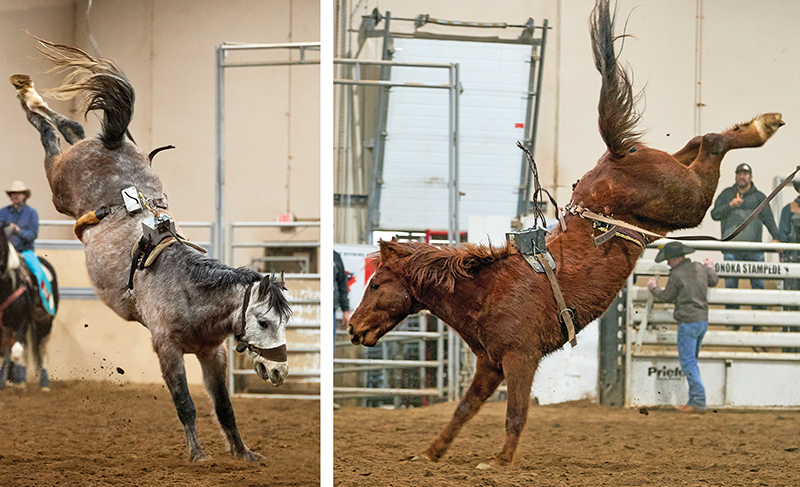
Broncs bucking with dummies at a Canadian Made Bucking Horse Futurity in January 2023 in Ponoka, Alberta. Photos: Wildwood Imagery
“The horses only work eight sconds at a time maybe 10 times a year,” says Siklenka. “That’s under two minutes of work per year.
“When they get older, they get a little slower and they’re not strong enough for the open guys anymore,” Siklenka explains. “So they move back down into the novice rider competitions. They teach the novice riders as much as anybody else because they’ve been doing it so long.”
Purpose-Bred Buckers
Some producers (breeders) and contractors have up to 100 breeding mares. For example, Calgary Stampede Ranch has been breeding “CS” branded horses since 1961 and has approximately 500 horses pastured on their 22,000-acre ranch near Hanna, Alberta.
But bucking horses weren’t always purpose-bred.
In 1915, a Thoroughbred-Percheron-Morgan colt named Midnight was born near Fort Macleod in southern Alberta. He became a legendary bucking horse and the first animal inducted into the Canadian Rodeo Hall of Fame. Broke as a saddle horse, he dumped his rider so often that at eight years old, he was taken to the local rodeo for cowboys to try their luck riding him. At that time, cowboys used their own ranch-riding saddles and had to stay on for ten seconds. But nobody could ride Midnight. In 1924, he was the champion bucking horse of Western Canada at the Calgary Stampede and when he was retired in 1933, only nine cowboys had ever ridden him in over 500 attempts.
Around the time Midnight retired, an American character named Feek Tooke, who was hosting rodeos in Montana, was struggling to find enough bucking horses. There simply weren’t enough wild horses to round up or rank unrideable ranch horses for bronc riders to compete on.
Related: Remarkable Horses in Canada: Midnight
Related: What Makes a Good Barrel Horse?
Horsemen of the day didn’t believe that bucking was a trait that could be bred — it was simply considered an outburst by horses that didn’t want to be ridden. Tooke wasn’t convinced. He decided to try breeding horses that would buck for eight seconds with power and athleticism. He started by breeding an ornery Shire stud to hot Arabian mares, and the resulting offspring gained fame as consistent buckers. Soon, rodeo riders wanted to draw Tooke-bred horses, knowing they’d have great rides which would earn better competition scores. As demand for his consistent buckers increased and former naysayers started changing their minds about the possibility of breeding a buck into horses, Tooke sold breeding stock to others keen to develop their own bucking lines.

Photo: Wildwood Imagery
Some of those breeders were Canadian. For example, the Keslers bred bucking horses for over 70 years in southern Alberta and Montana, and contracted stock to Professional Rodeo Cowboy Association (PRCA) and Canadian Professional Rodeo Association (CPRA) rodeos in the US and Canada. Gene and Joy Allen bred and raised bucking horses for 37 years in Kispiox, BC before retiring and dispersing their horses in 2010.
Today, there are over 20 bucking stock breeders in Canada and some of their horses are registered with the Bucking Horse Breeders Association (BHBA), based in Utah, US. The breed registry began in 2016 to record and preserve bucking horse pedigrees across North America.
“Bucking horses aren’t just a group of ‘brumbies’ anymore,” says Siklenka. “Breeding buckers is a really in-depth, serious activity. It might take 40 years to breed a superstar.”
That’s how the great bay bucking stallion Grated Coconut was produced. He was the star of the Calgary Stampede’s breeding program. Between 2003 and 2009 he won Bareback Horse of the Year six times from both the PRCA and CPRA. Grated Coconut had 114 outings and a reputation for scoring well, helping 25 riders win. If riders could stay on him, they made money. His bloodlines were in high demand when he retired to stud. (See sidebar Grate Expectations.)
The Bronc Market
There’s a healthy market for bucking horses. On November 3, 2023, Canadian Made Bucking Horses (CMBH) held a bucking horse auction at CFR49 in Red Deer, Alberta.
“Eighty percent of the horses that we sell go to US buyers,” says Buck Peters, organizer of the non-profit CMBH and a bucking horse breeder. CMBH began during COVID-19 when stock contractors didn’t have any way to sell their horses and now offers seven competitions to showcase Canada’s bucking stock. In 2023, over 400 broncs competed in those competitions and the top 35 horses were eligible for the November auction.
Related: Cutting - A Sport of Precision and Strategy
Related: Head First - Horse Riding Accidents and Concussions
This year, buyers in Texas, Utah and Wyoming purchased the top three horses for $15,000 to $22,000. In 2022, the top selling bronc at the CMBH fall auction went for $60,000 with another selling for $41,000.
Peters explains that high selling horses are usually aged seven to 10, and 80 percent of their value is in their ability to produce consistent rides.
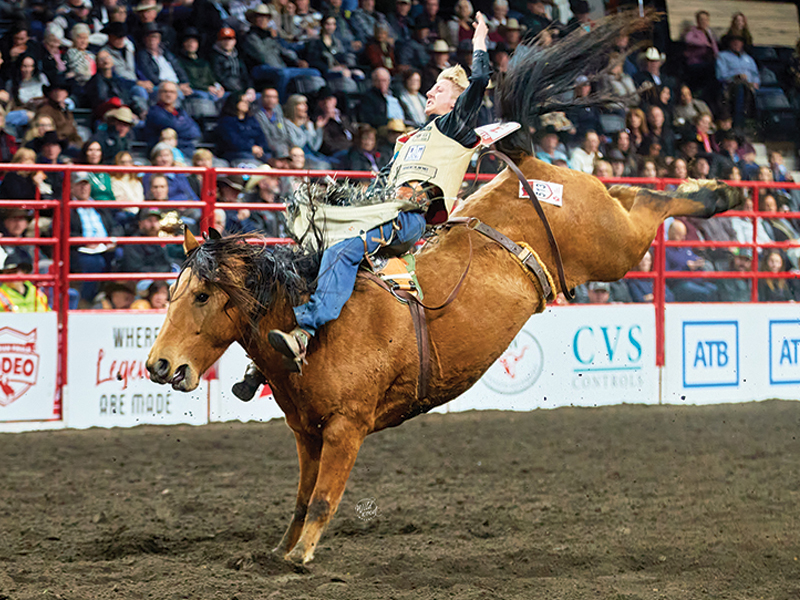
Photo: Wildwood Imagery
“It’s hard to find professional calibre horses that are ready to travel to rodeos right away,” says Peters. “Those are the ones that get top prices.
“There’s always space for more producers because only about 10 percent of colts that are born become successful buckers,” says Peters. “Probably six out of 10 are going to dummy well. Then two or three out of those six will make it as bucking horses, and probably one will make it to the higher levels.”
For horses that don’t want to buck, there are other markets. Draft crosses are in demand by outfitters, teamsters, ranchers, and even performance riders looking for their next athlete.
“They’re big boned and well-muscled, so there’s always other places for them to go to work,” says Siklenka.
“A lot of guys are selling them for riding horses,” says Peters. “We have two riders that come to our ranch, and they’ll take anything that doesn’t want to buck.”
Horse Welfare
Aside from training, travelling, and competing, bucking horses generally enjoy the “three f’s” of friends, freedom, and forage in greater quantities than some other equine athletes. Most bucking horses live in a natural state during “the other 23 hours” in family groups on large pastures. They have their feet trimmed, get vaccinated, and are handled regularly.
When bucking horses arrive at a rodeo, they’re checked to ensure they’re healthy.
“We inspect every horse upon arrival,” says Lane Peterson, the Lead Official at CFR49. “I work with a representative of the stock contractors, and we look for any issues that might affect a horse’s health or performance.”
Related: Changing Equine Disciplines
Related: Roping 101 - Cowboy School
Peterson isn’t a veterinarian but notes that every day a designated veterinarian walks through all the horse pens and checks every horse for signs of injury or distress.
“There can be an injury, muscle soreness, that kind of thing,” says Peterson. “We make the best decision for the horses based on what we observe. Contractors do their absolute best to help their animals perform at their highest level.”
In an effort to understand how bucking horses feel about performance, Temple Grandin and two others conducted a three-year study at the Calgary Stampede into the effect of rodeo procedures on the behaviour of bucking horses. They evaluated 116 horses in the Bareback, Novice Bareback, Saddle Bronc, and Novice Saddle Bronc events, recording the behaviour of humans and horses while the horses were loaded into and held in the chutes prior to their performance. The study results, published in Applied Animal Behaviour Science¹ in 2021, found that horses with greater numbers of rodeo experiences balked less when entering the chutes and were less likely to display “vigorous behaviours” prior to the rodeo performance. Additionally, “vigorous behaviour” prior to the rodeo was not related to better or worse bucking performance scores by judges. Importantly, the report stated: “The results of the role of experience and potential performance-related anticipatory behaviours is likely indicative of horses’ habituation to rodeo versus learned helplessness.” In other words, bucking horses learn to become calmer from a greater number of rodeo experiences and are not simply “giving up.”
Although more research is needed, this study and the support of the Calgary Stampede indicates there’s interest in doing what’s best for bucking horses.
Making Careers
Positive horse welfare means good performances by horses and good rides can make or break a rider’s career.
“The ideal bareback horse stays in one spot underneath you and really gets in the air, kicking its heels overhead every jump,” says Chad Siemens who, at age 18, won the Novice Bareback competition at CFR49. He’s at college in Casper, Wyoming and trains in the gym, on a mechanical bronc, and on live horses every week.
“The horse you draw is a big part of it,” says Siemens. “Four or five days before the rodeo, or sometimes on the day, you find out what horse you’ve drawn. I try to ask a few people, sometimes the stock contractor, what kind of horse it is.
“I have a buddy that helps set my rigging in the chute and the stock contractor usually tightens the flank strap,” Siemens explains. He went to over 60 rodeos in 2023 and plans to try the open competitions in 2024 with a view to getting his professional card and making a living riding broncs.
“Riding bucking horses takes hard work and determination but the biggest thing is to just keep getting on,” says Siemens. “I’ve always been told that a teaspoon of try beats a cupful of talent.”
Maybe that goes for bucking horses, too, and why bucking horse producers hang in there year after year, hoping to produce the next Midnight or Grated Coconut. The next great talent could be grazing in someone’s pasture right now.
Related: The Bishop Family Business: 100 Years of Wild West Shows
Related: Grated Coconut - The Greatest Bareback Horse of All Time
¹ Effect of animal’s experience and rodeo procedures on behaviour of bucking horses at a large commercial rodeo in Canada, Applied Animal Behaviour Science, Vol 234, January 2021, 105199, Temple Grandin, Christy Goldhawk, Ed Pajor. https://www.sciencedirect.com/science/article/pii/S0168159120302872
Main Photo: Wildwood Imagery



